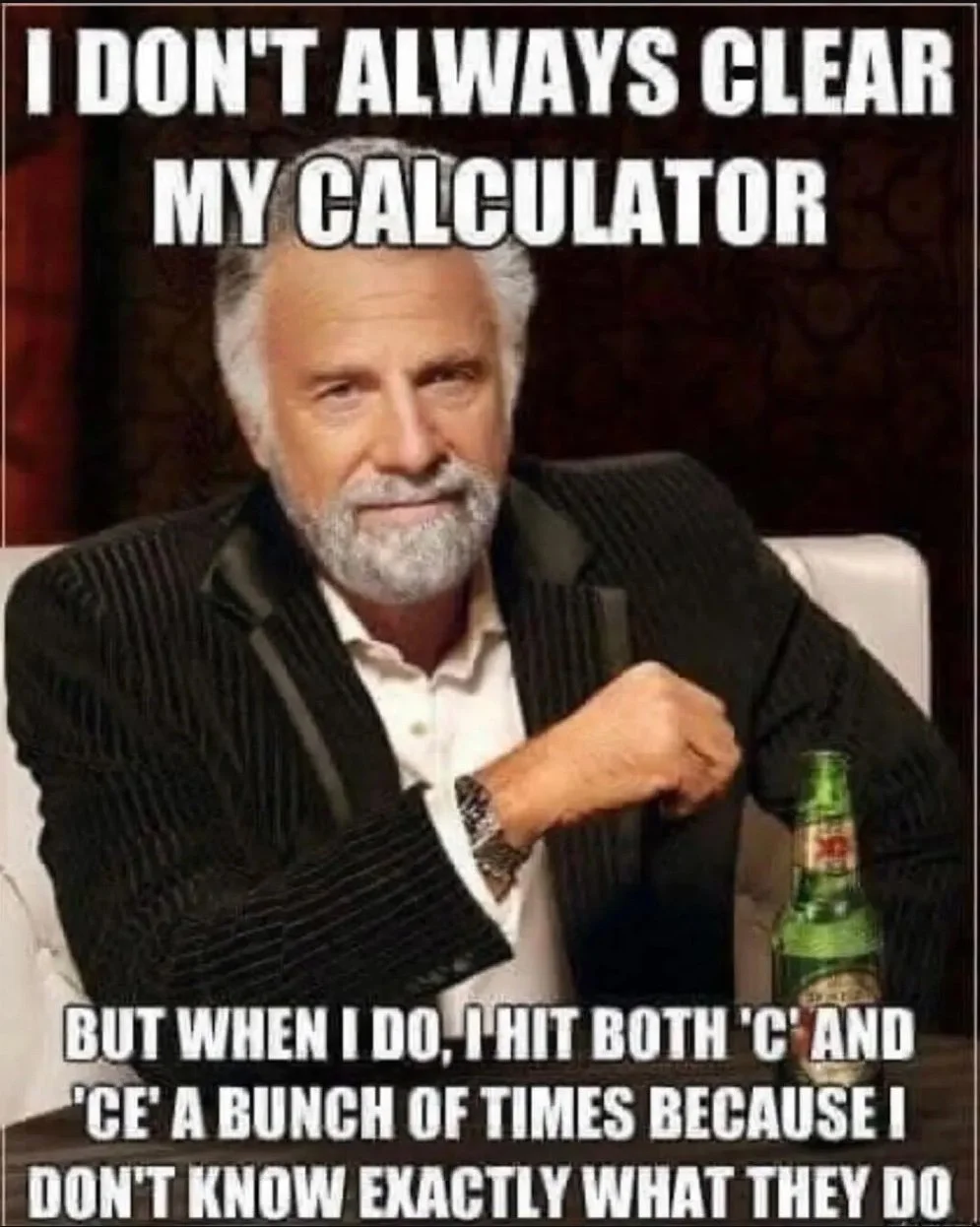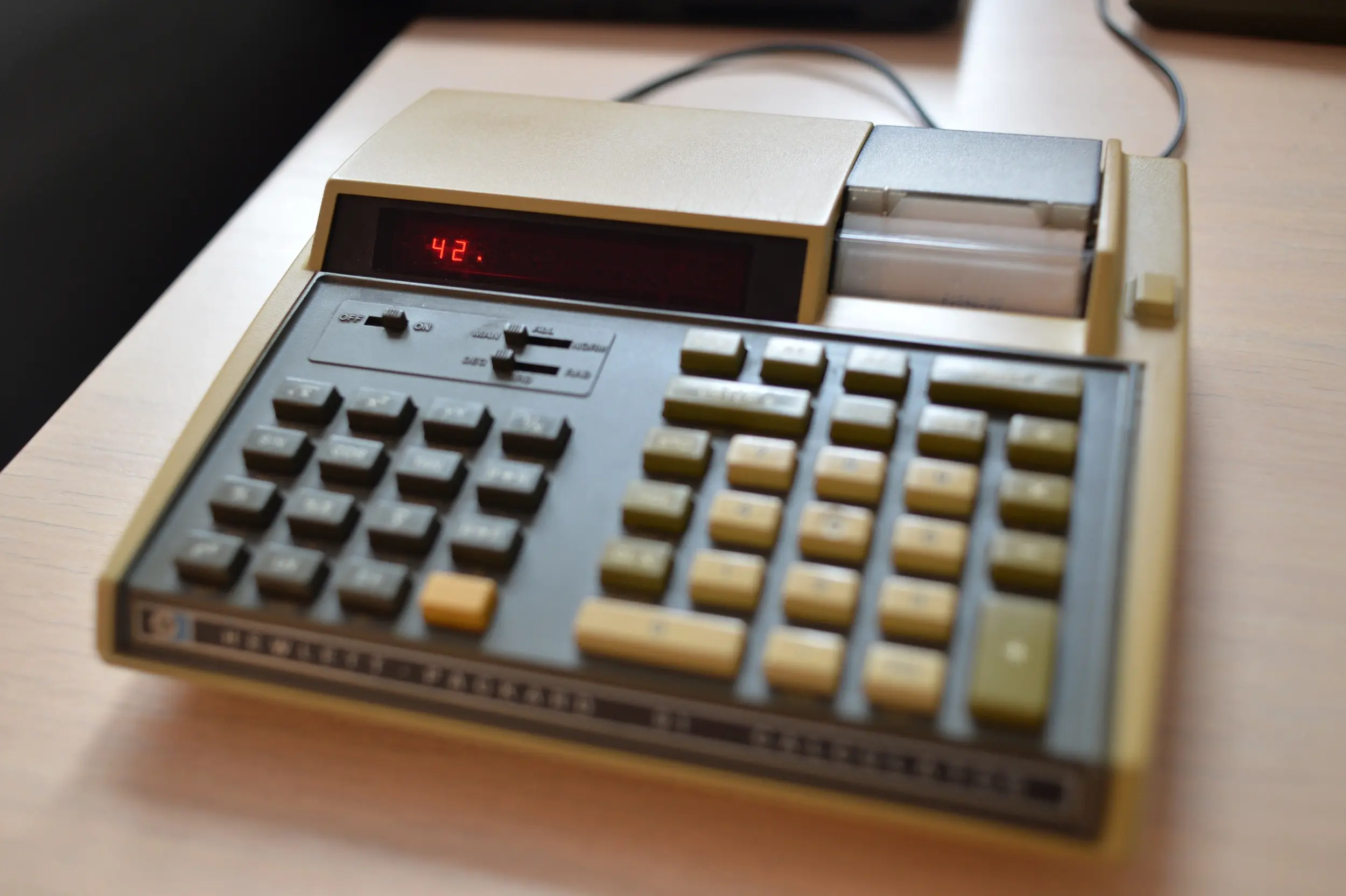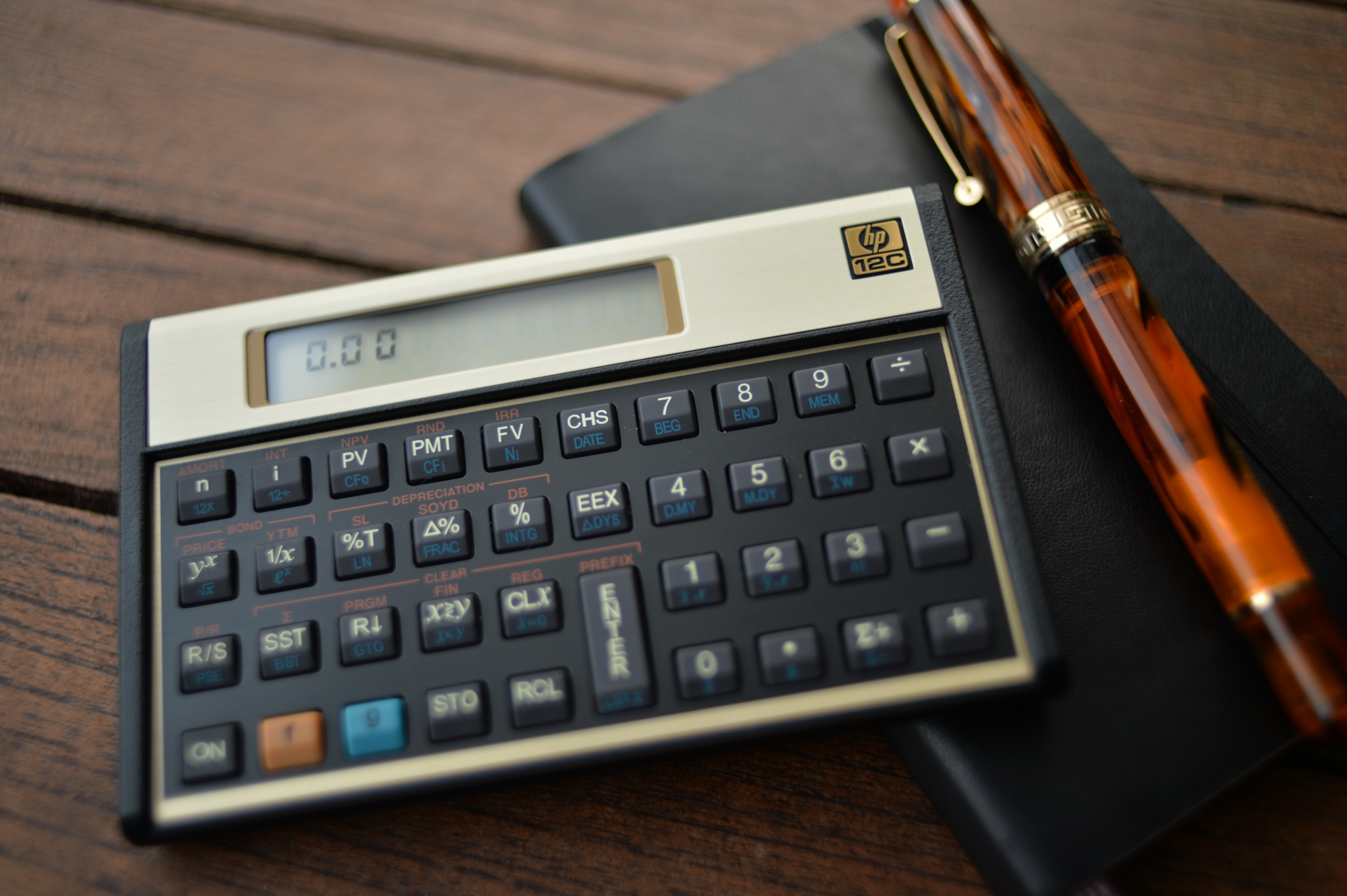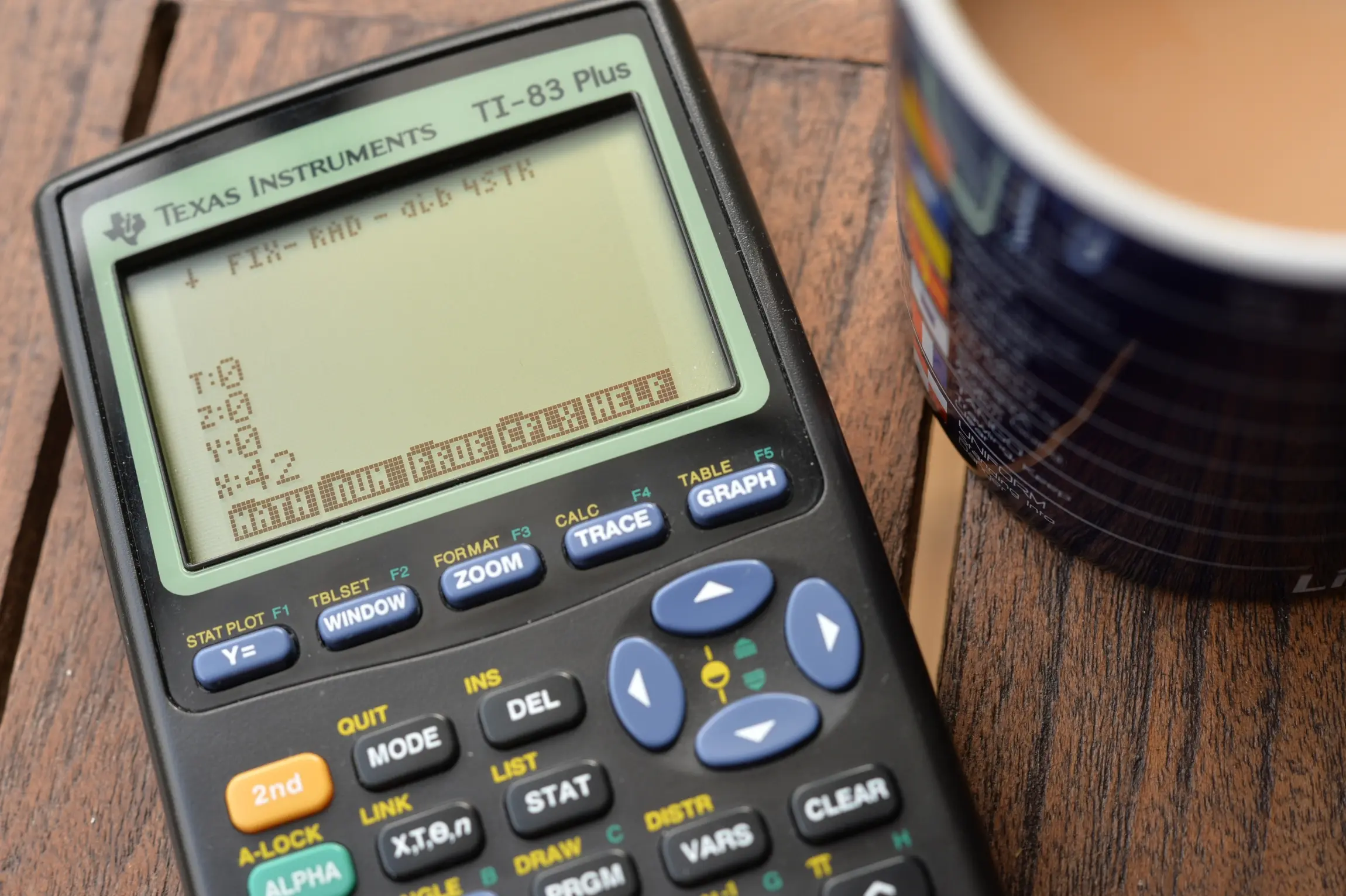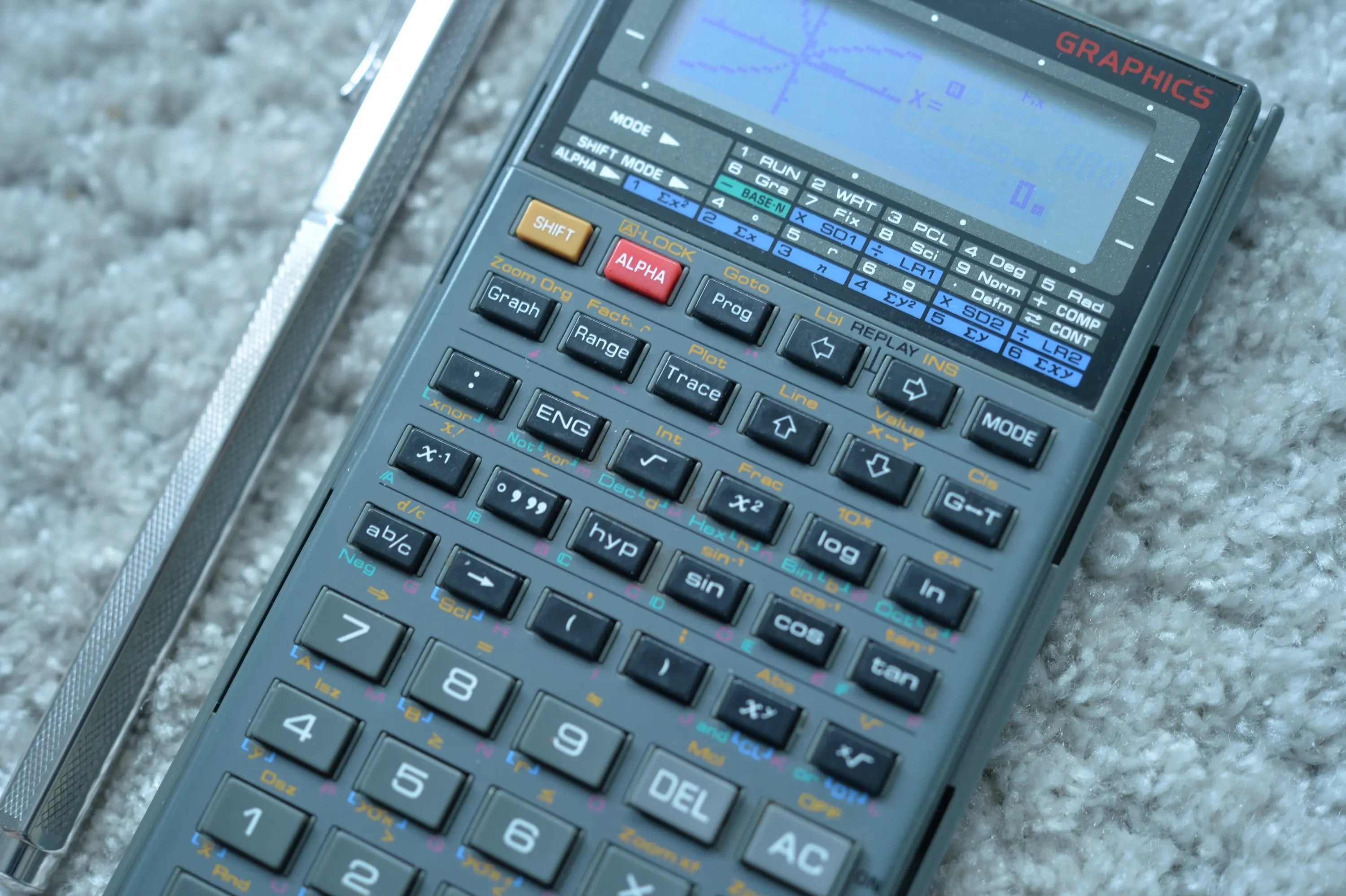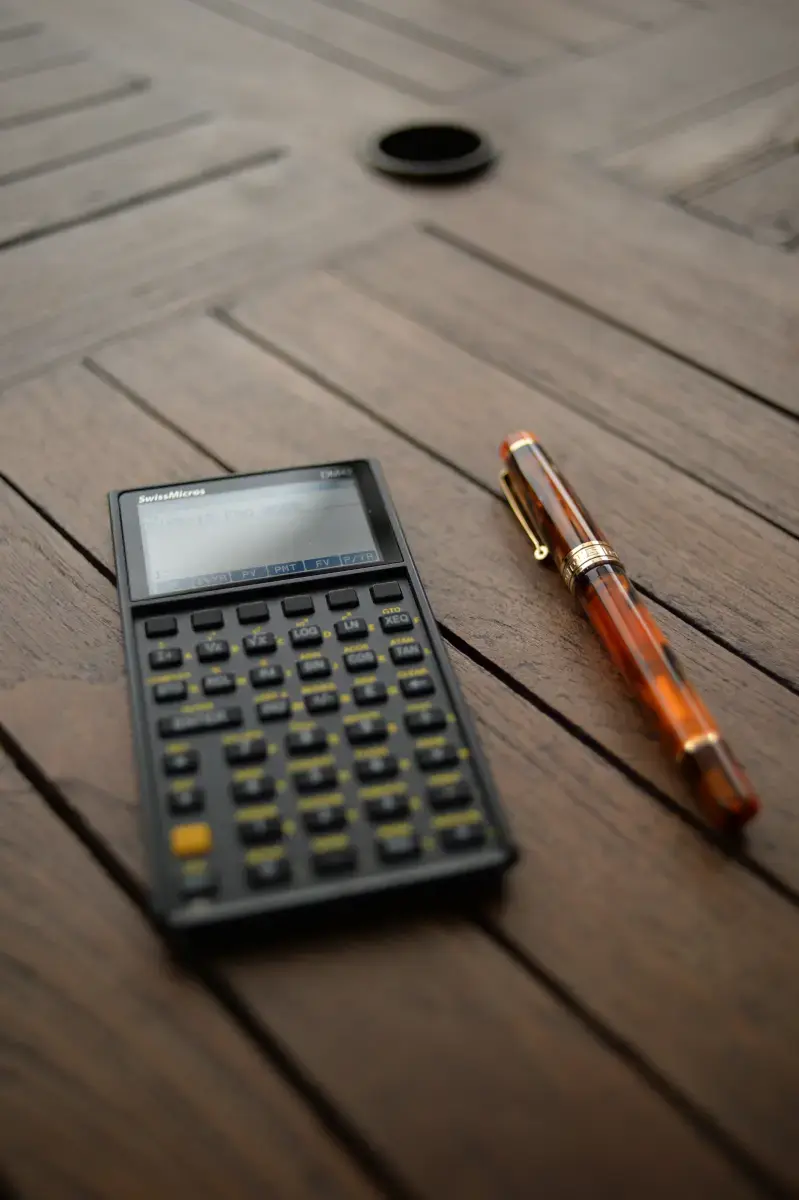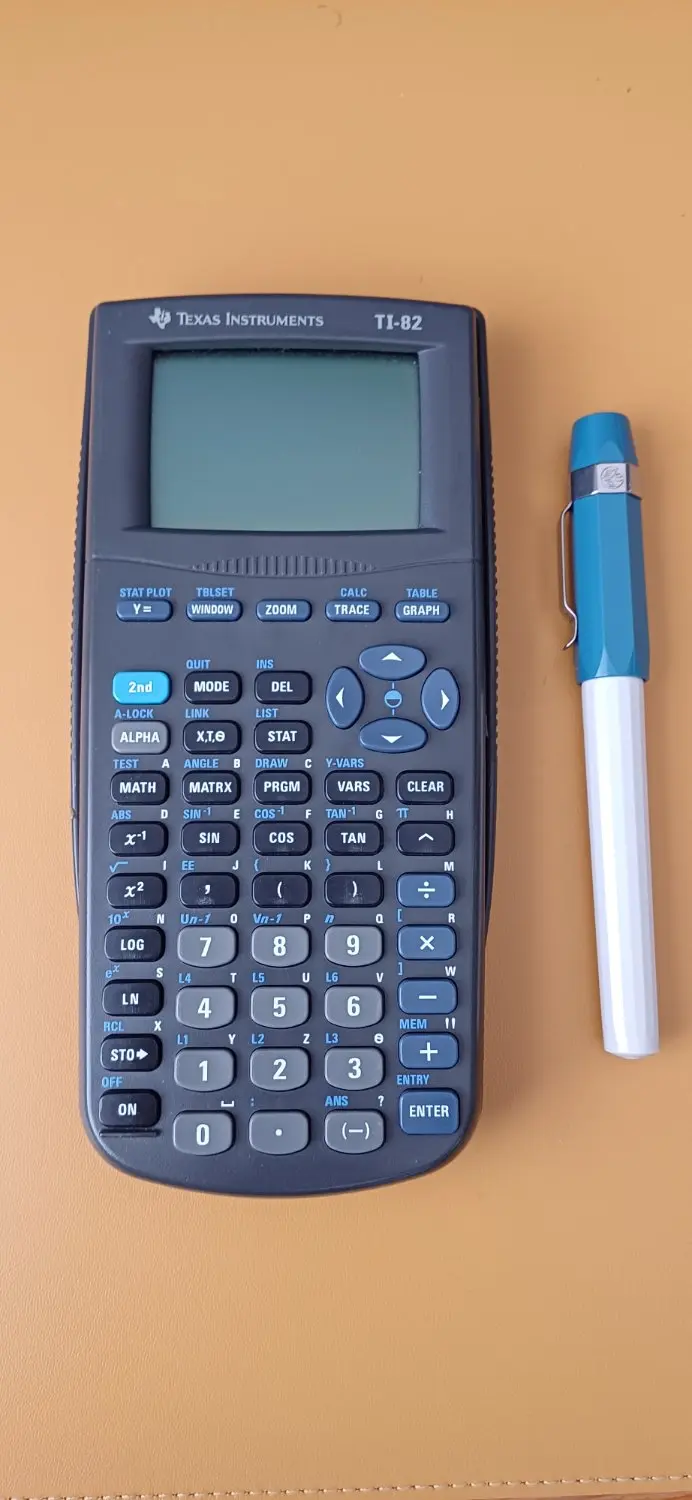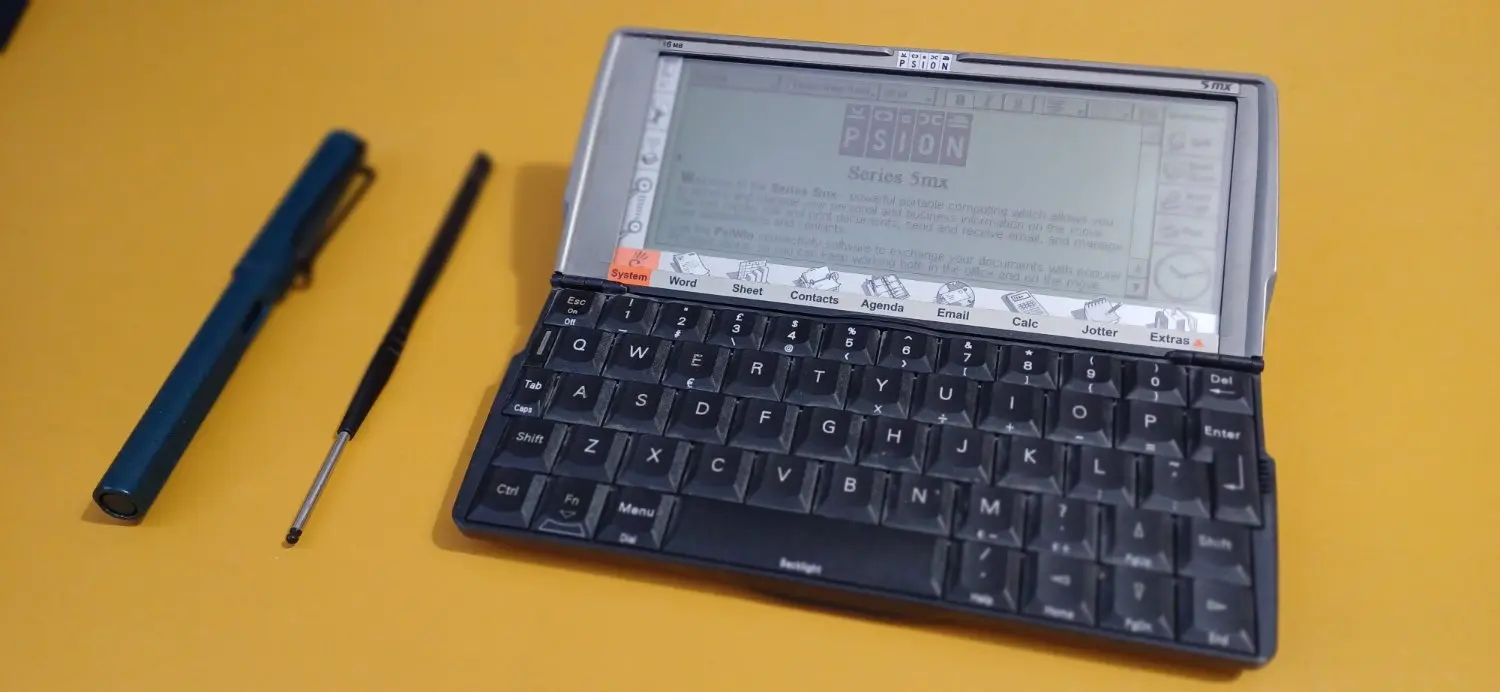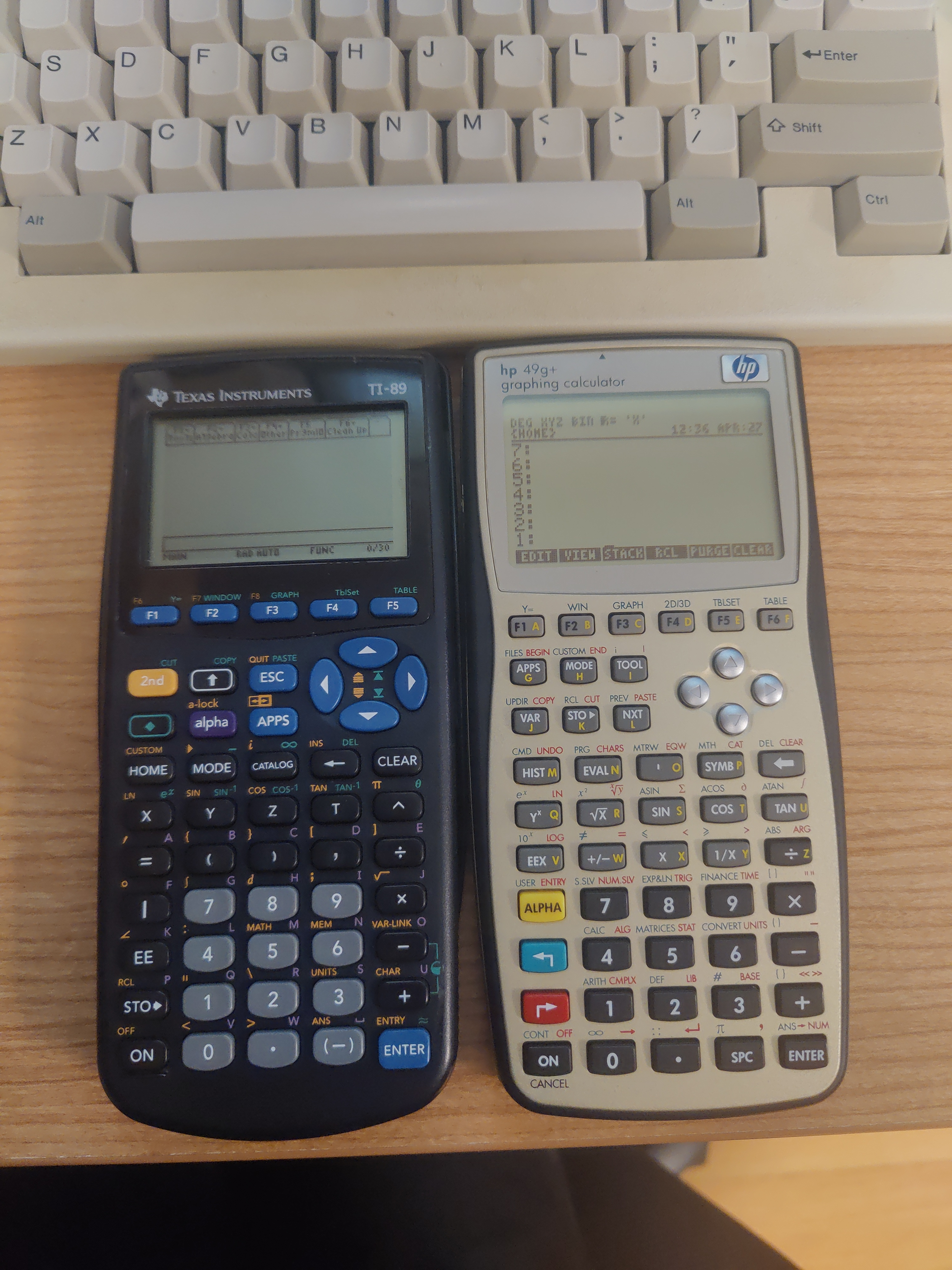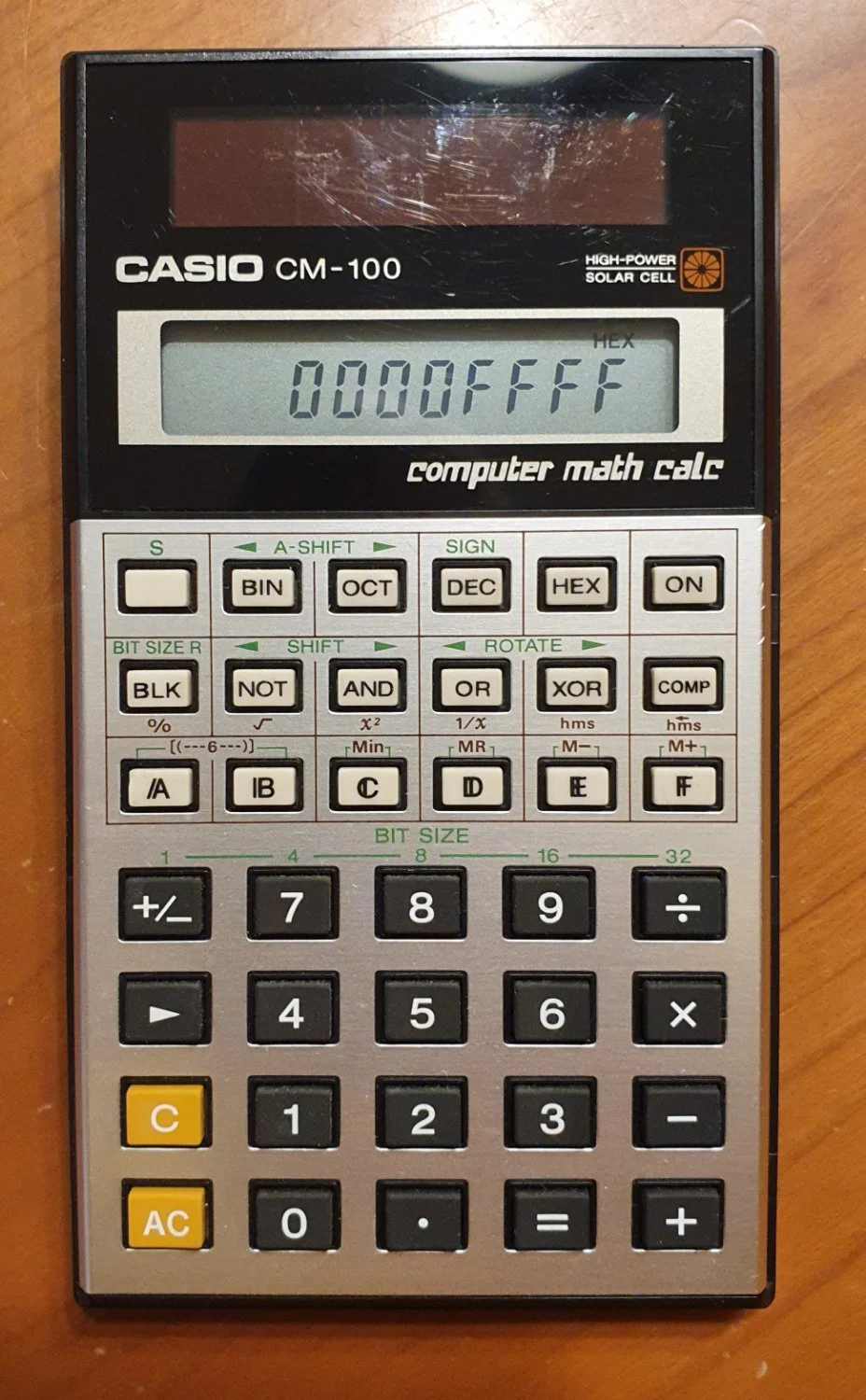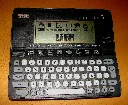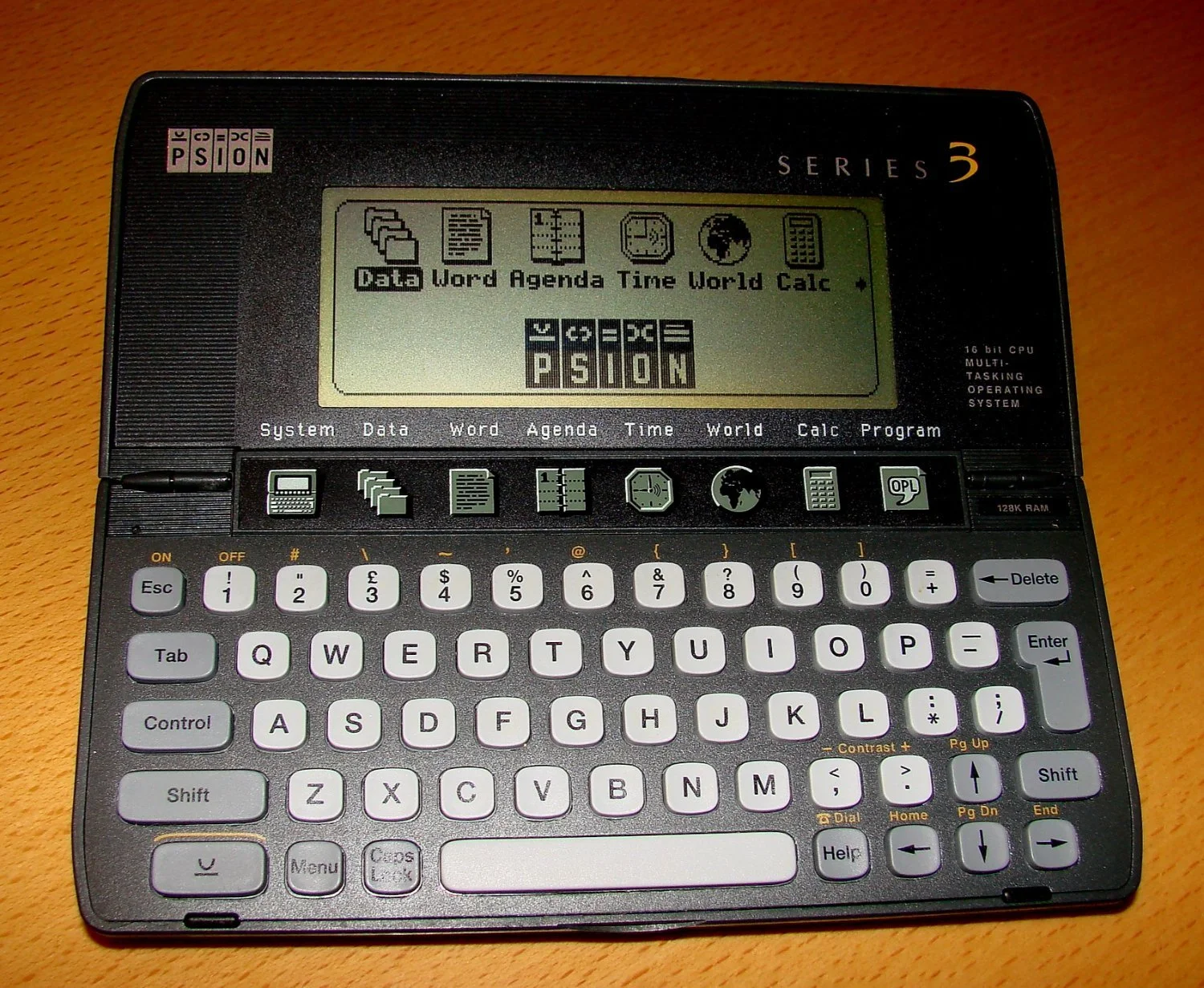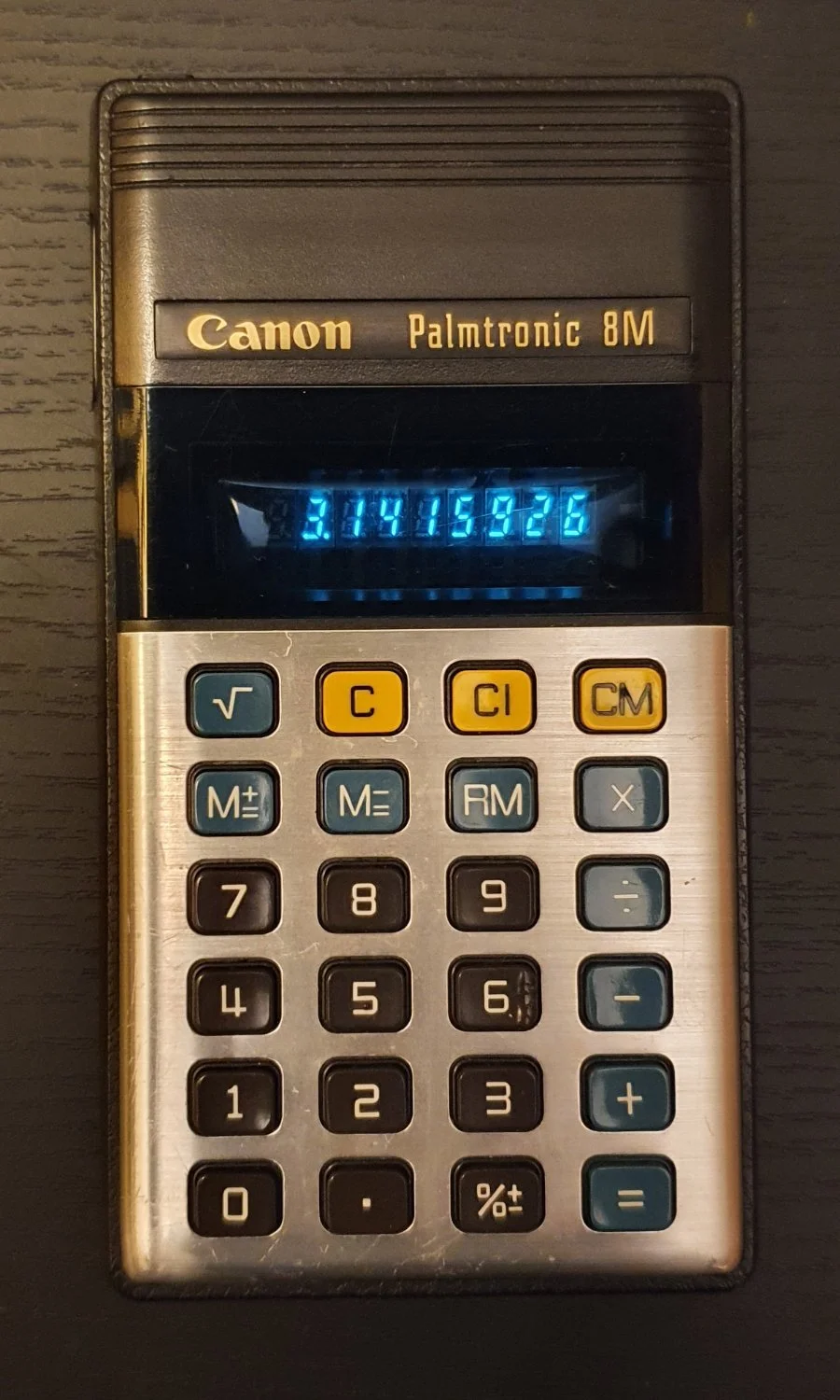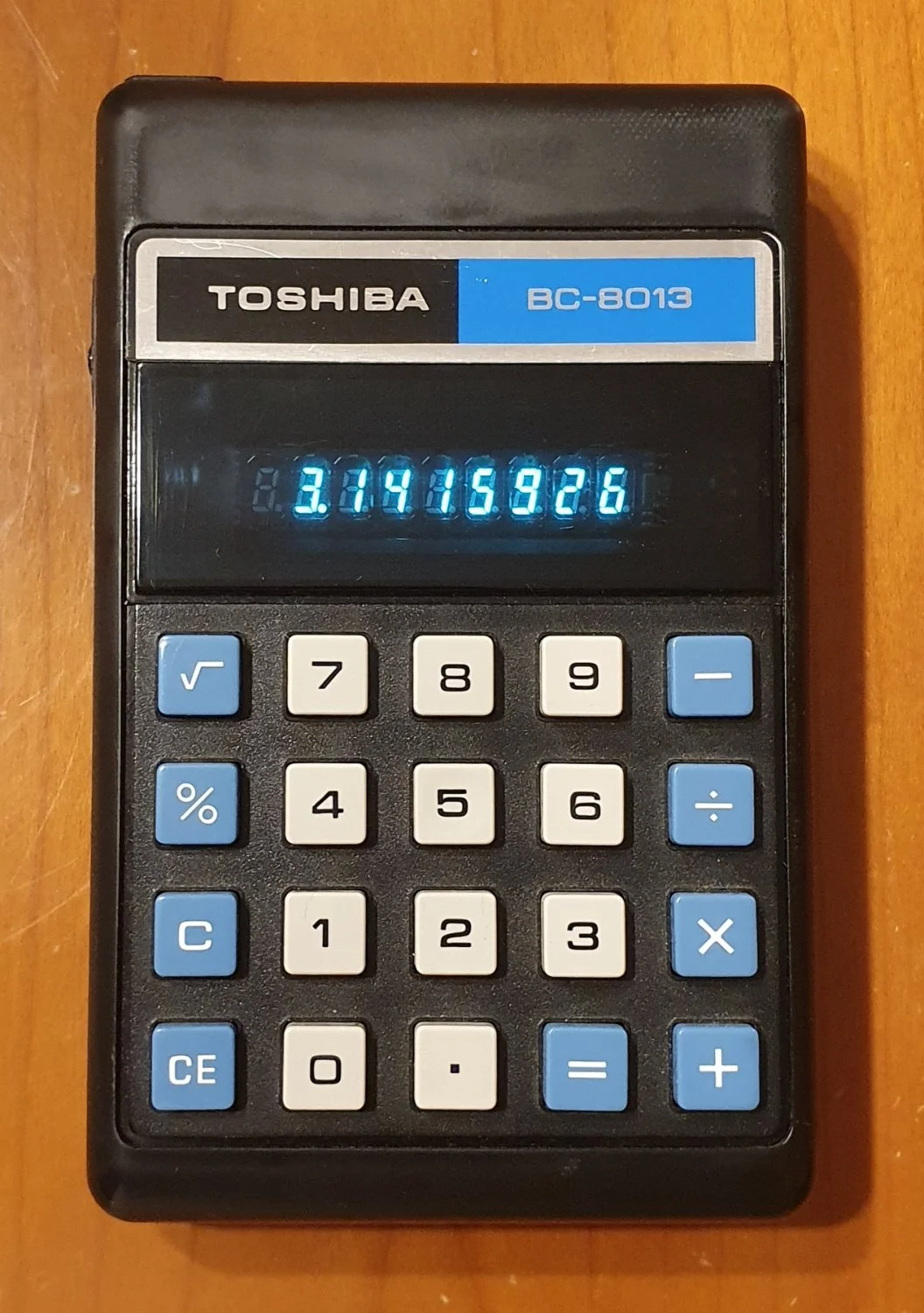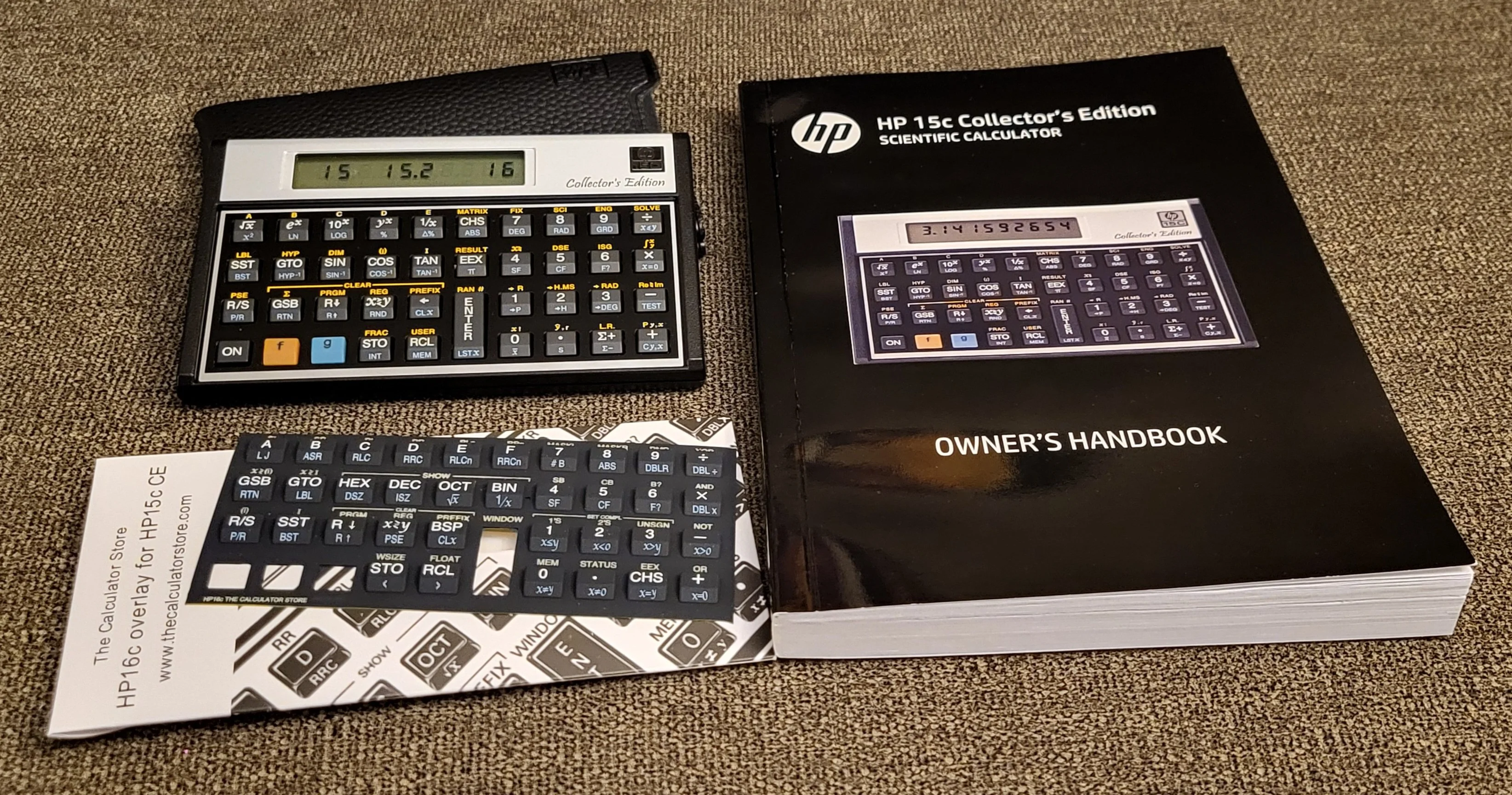-
The Start of My Obsession: Radio Shack EC-300

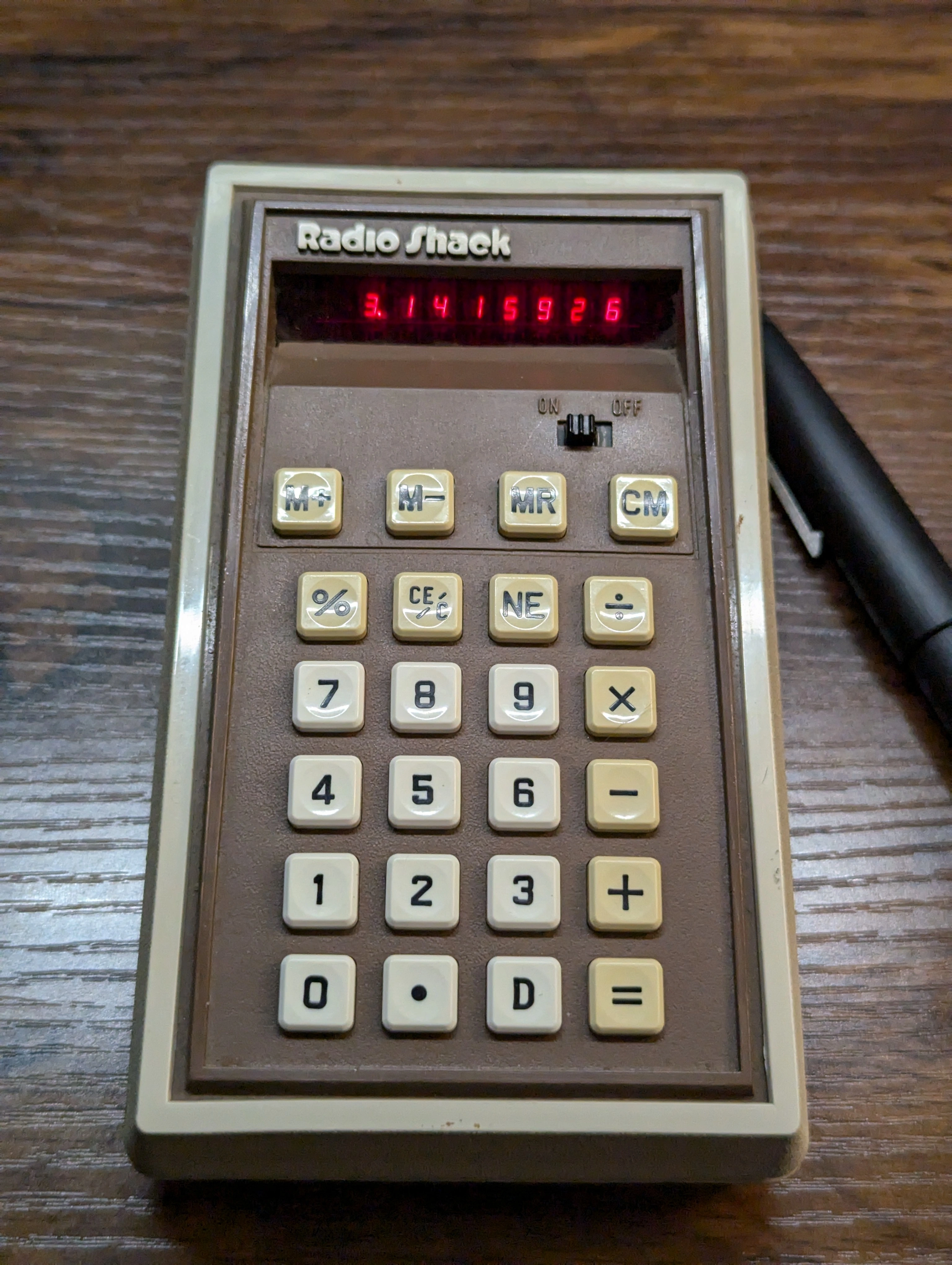
This is the calculator that my father bought for his senior year of high school in 1974. He showed it to me when I was four and I remember being amazed that a little box could add and subtract, captivated by the tiny red numbers. It was a few months later that he brought home our first computer, a Texas Instruments TI-99/4A, and I was again smitten. So much of the trajectory of my life can be traced back to those two objects.
When I opened the unit up I was not too terribly surprised to see a set of four AA batteries from the late 80's still installed, but I was very lucky that they hadn't leaked. I popped a new set in and it powered on with no issues. I played with it for a moment, the first time I had ever pushed the buttons on it, and placed it in the closet. I know it will be the perfect phylactery when I become a lich.
-
HP-65 and friends

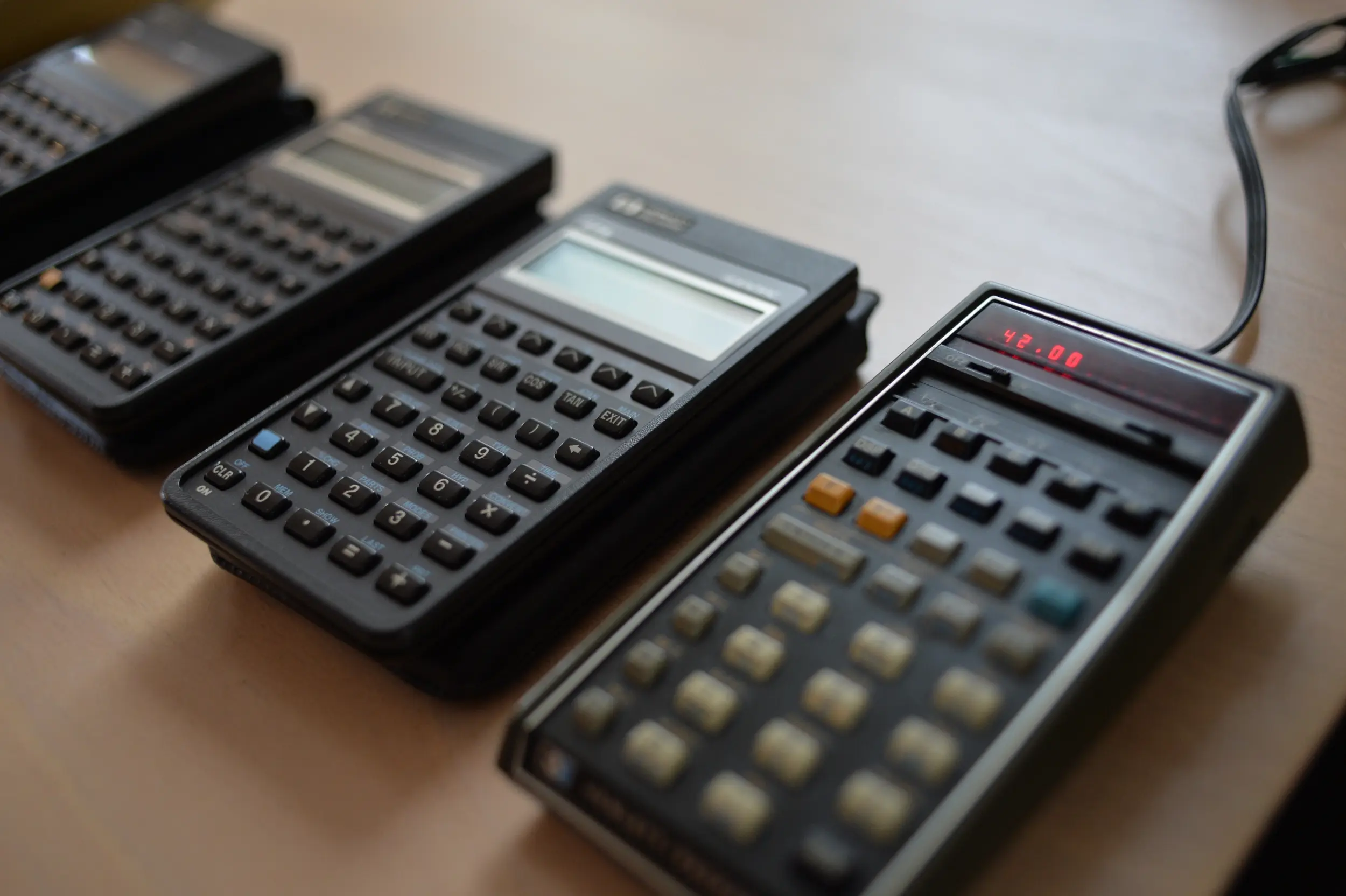
The HP-65 was not only HP's first programmable scientific, but it could also read and write magnetic cards. There were several 'pac's of cards allowing it to tackle financial, astronomical, aviation, electrical and other speciality field calculations. The buttons were double shot and have a lovely tactile click. The red LED screen is remarkably crisp and easy to read.
-
Forensic Financial Tests


These are the tests which can give you quite a good profile and accuracy rating for your financial calculator. Any more contributions and confirmation are very much appreciated and I will update the swissmicros page (though I may need to move it off there at some point). ``` | # | Ref | N | I%YR | PV | PMT | FV | P/YR | Mode | |----|------------|--------------|-----------|----------|--------------|-----------|------|-------| | 1 | DM | 38 x 12 | 5.25% | 270'000 | ? | 0 | 12 | end | | 1b | DM | 38 x 12 | ? | 270'000 | -14'584/12 | 0 | 12 | end | | 2 | SlideRule | 360 | 15% → 12% | 100'000 | ?-? | 0 | 12 | end | | 3 | Kahan 1983 | 60x60x24x365 | 10% | 0 | -0.01 | ? | =N | end | | 4 | DM | 480 | 0 → ? | 100'000 | ?→ PMT | 0 | 12 | end | | 5 | Dieter | 10 | ? | 50 | -30 | 400 | 1 | end | | 6 | Dieter | 10 | ? | 50 | -30 | 80 | 1 | end | | 7 | A Chan | 10 | ? | -100 | 10 | 1e-10 | 12 | end | | 8 | Miguel | 32 | ? | -999'999 | 0 | 1e6 | 1 | end | | 9 | DM | ? | 25 | 100000 | -2083.333334 | 0 | 12 | end | | 10 | DM | ? | 25 | 100000 | -2040.816327 | 0 | 12 | begin | | 11 | robve | 60x24x365 | 1/6% → ? | 0 | -0.01 | ?→ FV | =N | end | | 12 | robve | 40 | ? → I%YR | 900 | -400 | -1000 → ? | 1 | begin |
2: https://www.hpmuseum.org/forum/thread-20707.html 3: https://www.hpmuseum.org/forum/thread-1012.html 5, 6: https://www.hpmuseum.org/cgi-sys/cgiwrap/hpmuseum/archv021.cgi?read=234439 7: https://www.hpmuseum.org/forum/thread-18359-post-161549.html#pid161549 8: https://www.hpmuseum.org/cgi-sys/cgiwrap/hpmuseum/archv017.cgi?read=120592 11, 12: https://www.hpmuseum.org/forum/thread-16565-page-2.html ```
Puzzle 2 is from here, and needs you to calculate PMT given n = 360, I%YR = 15%, PV = 100'000, FV = 0, then calculate PMT, but with I%YR = 12%. Subtract the two results, and put that back into PMT, then change n = 36 and I%YR = 15% again, and calculate PV.
Puzzle 3: you may need to divide I%PY by N depending on how your calculator handles i vs I%YR and what the limit is on P/YR.
Puzzle 4 needs you to calculate PMT first given I%YR = 0, then re-input this back into PMT and calculate I%YR. On the HP-12c this is best done by pressing x<>y twice before putting back into PMT.
Puzzle 11: calculate for FV first, re-input back to FV and compute I%YR.
Puzzle 12: calculate for i first, re-input back into i and compute FV.
The other puzzles are just a solve for '?'.
They can be a bit confusing, so I also did a couple of videos here and here solving them on a DM-42 and HP-12c.
-
Sea, beer and a calculator.


A random shot of my calculator 5000 miles from home while I enjoy a beer near the Pacific. We had been discussing how much water was on earth and what size of a ball it would make. I have no affiliation with the brewing company so apologies for the product placement.
-
Ooh are we doing Troncet adders? Here's my Addiator


Here's a video from Chris Staecker showing off a similar one: https://youtu.be/2mv45XP48bQ?si=BJmt9rRG-wXdn_jA
-
New Casio Graphing Calculator Incoming


I just got an email from Casio Education saying that the next graphing calculator is coming next summer, and that prototypes will be shown off at the National Council of Teachers of Match Expo. I'm in the Chicago area, but tickets for non-members are way outside of my discretionary budget. If anybody is going, you'll have to fill us in!
-
Texas Instruments TI-nspire CX CAS


The TI-nspire CX CAS was my first calculator with in integrated CAS, and it was a revelation! I was amazed that a handheld calculator could do symbolic logic, even though the technology goes back to the late '90s. I just never knew that it was a thing. The UI and software for the CX is almost identical to the CX II, though the CX II is more than twice as fast. The touchpad in the middle of the directional button was also improved quite a bit on the CX II. I still use this guy quite a bit, just because it is a special calculator to me. The CAS is not as full-featured as that on either the HP Prime or the Casio fx-CG500, but still powerful as hell. The CX also does not have the third-party support that the TI-89 Titanium has, but is many times faster than it and has the benefit of using a UI that was designed for its form factor.
The pen is an Asvine V200 Titanium M.
-
HP-12c Platinum

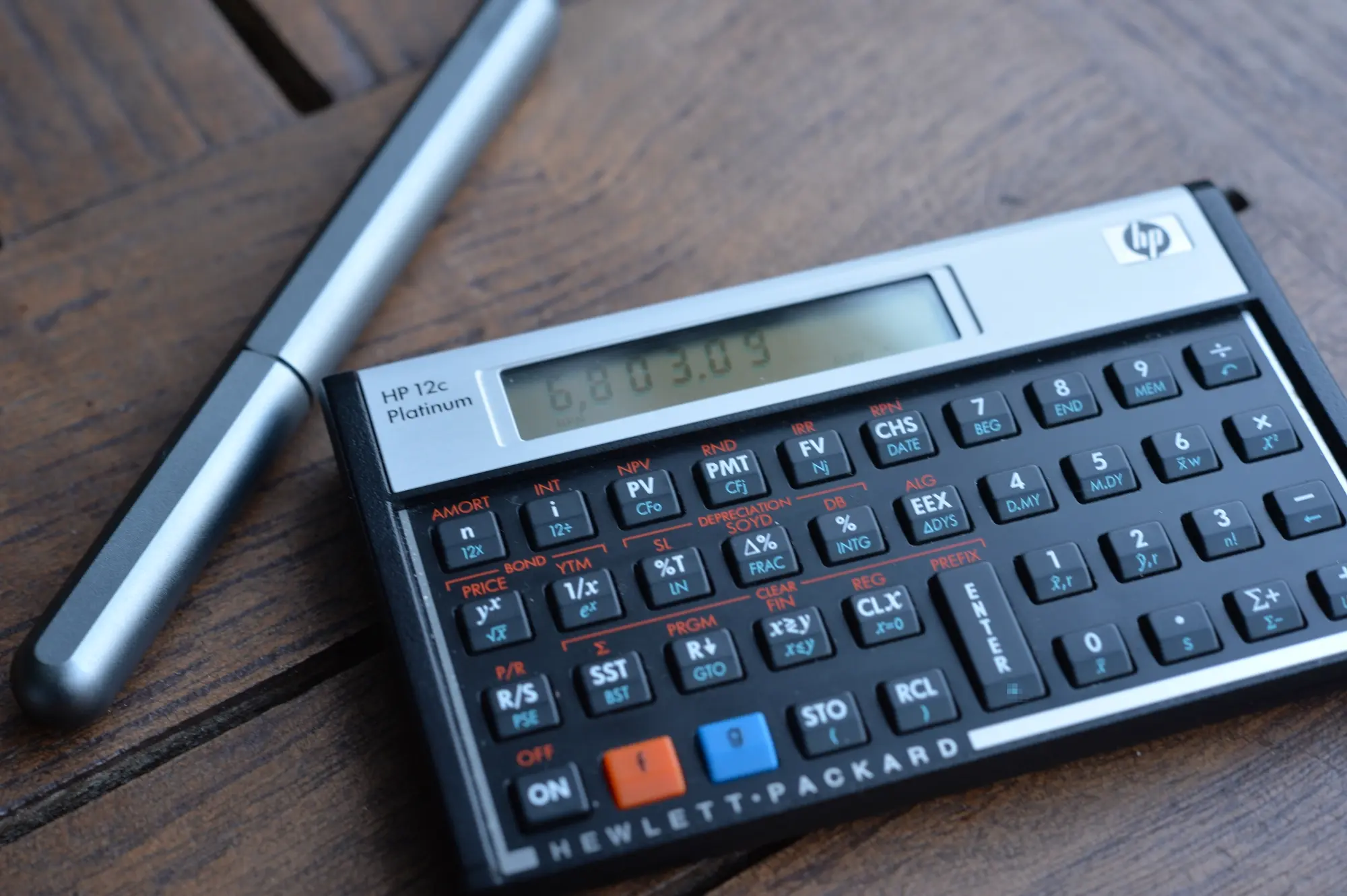
HP's most accurate financial calculator, oddly enough, and despite only returning the ceiling of solve-for-n.
-
Casio BN-20

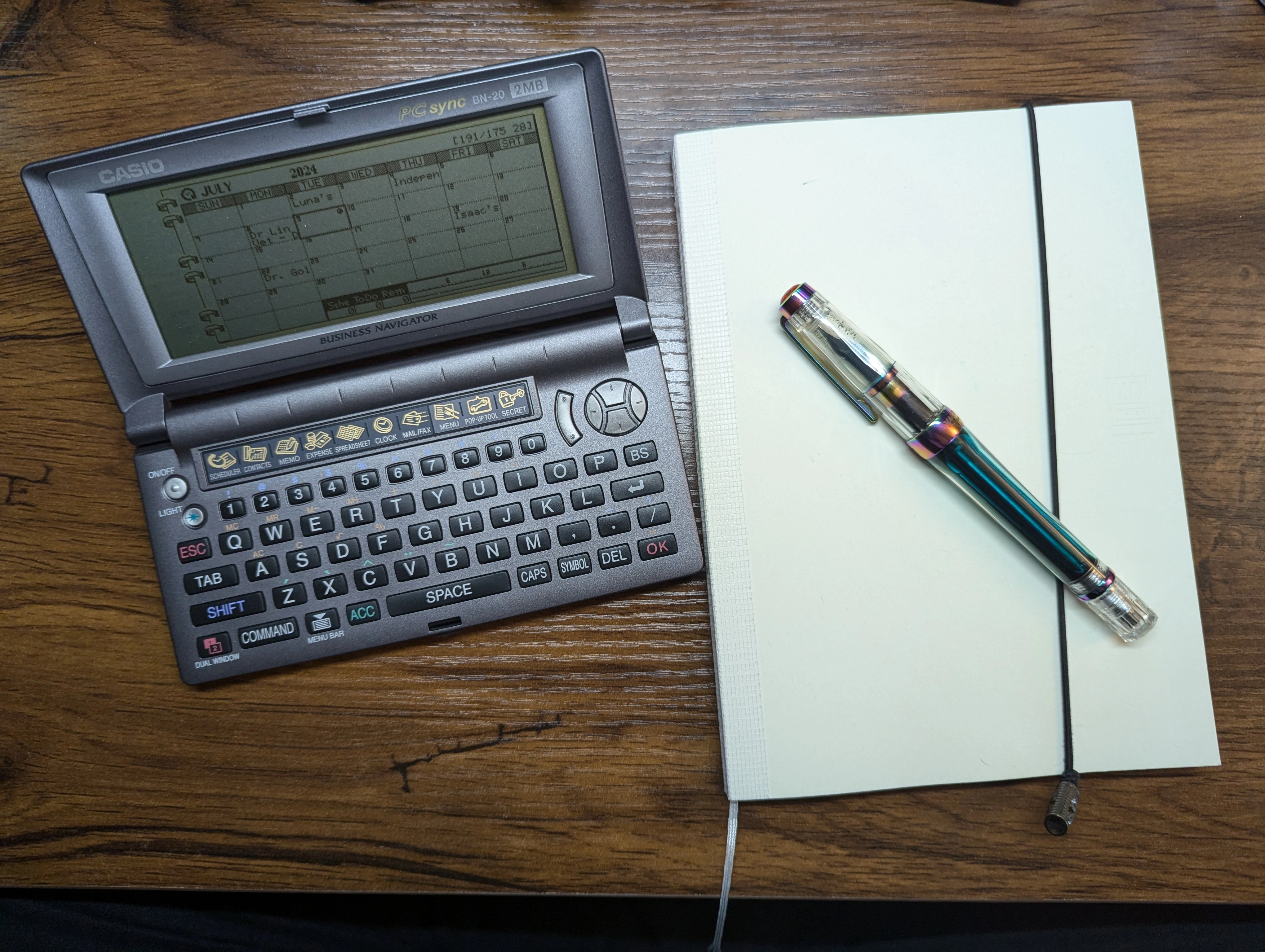
Sorry the angle is a little funky, but this is one of my two workhorses, the Casio BN-20. This guy gets used almost every day, and is my primary source of truth for my calendar and contacts. It was released in 1998 and has 2 MB of user memory. The spreadsheet function is pretty rudimentary, and the only function that I don't have a lot of experience with. The expense function is the best expense tool I've ever seen on an electronic organizer. I run Xubuntu on modern hardware and can sync the data using Casio PC Sync through Wine and with a USB to serial converter.
-
My graduation gift, a TI-82

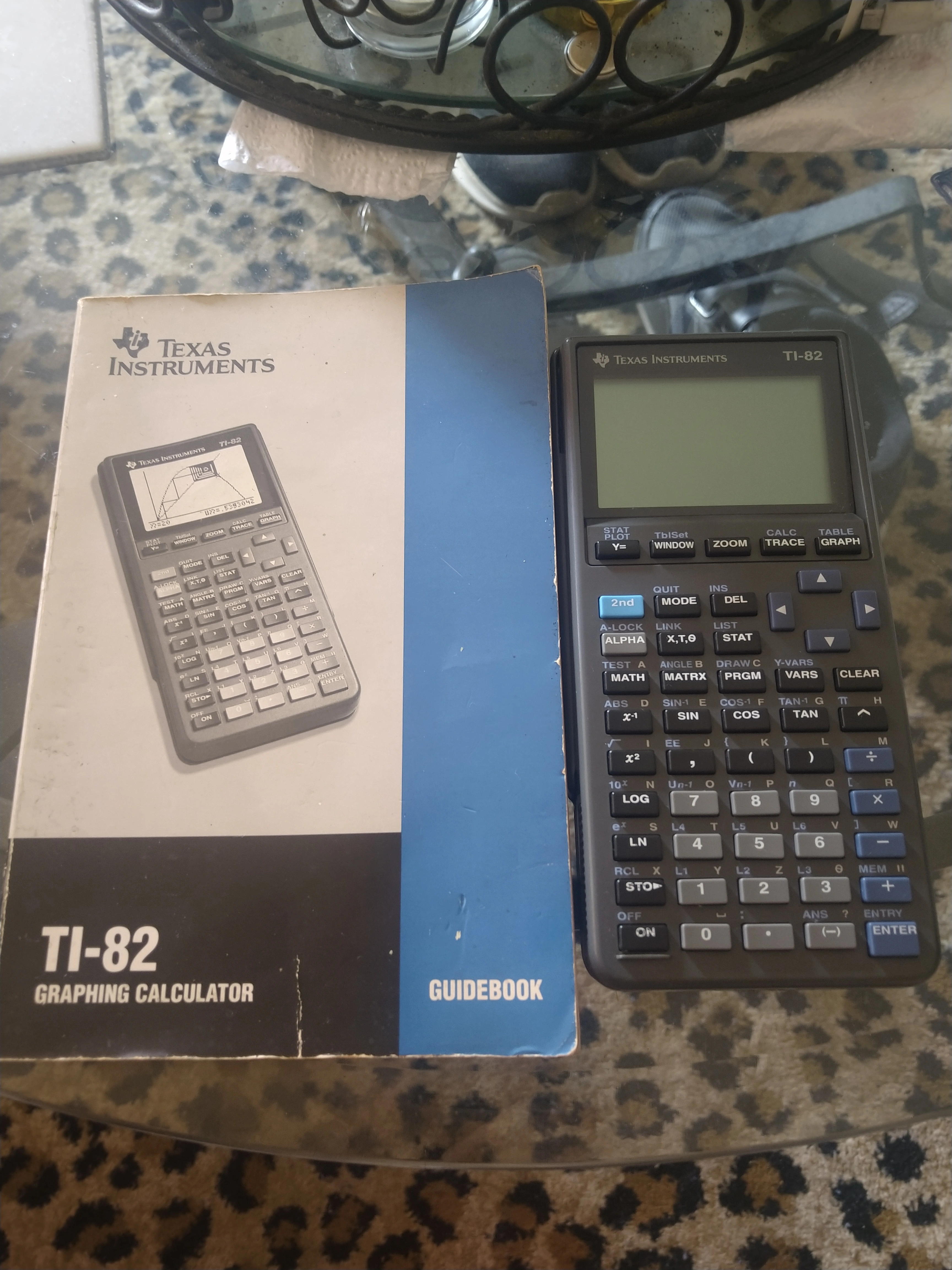
A gift from my Calculus teacher upon graduation.
Yes manual included. Sadly the 0 (zero) button no longer works, due to battery corrosion... ☹️
-
My old TI-36X Solar


This is the calculator that got me through junior high and high school. It even handles fractions, which is what you see on the display there.
355/113 is a very close approximation of PI, accurate to 6 decimal places.
Yes the calculator also has a proper constant for PI, but 355/113 is a pretty nifty trick in it of itself.
355/113 = 3.14159292, at least on this calculator.
-
TI-30 (1976)


This example was manufactured on the 7th week of 1979.
https://www.calculator.org/calculators/Texas_Instruments_TI-30.html
-
Curta Type I

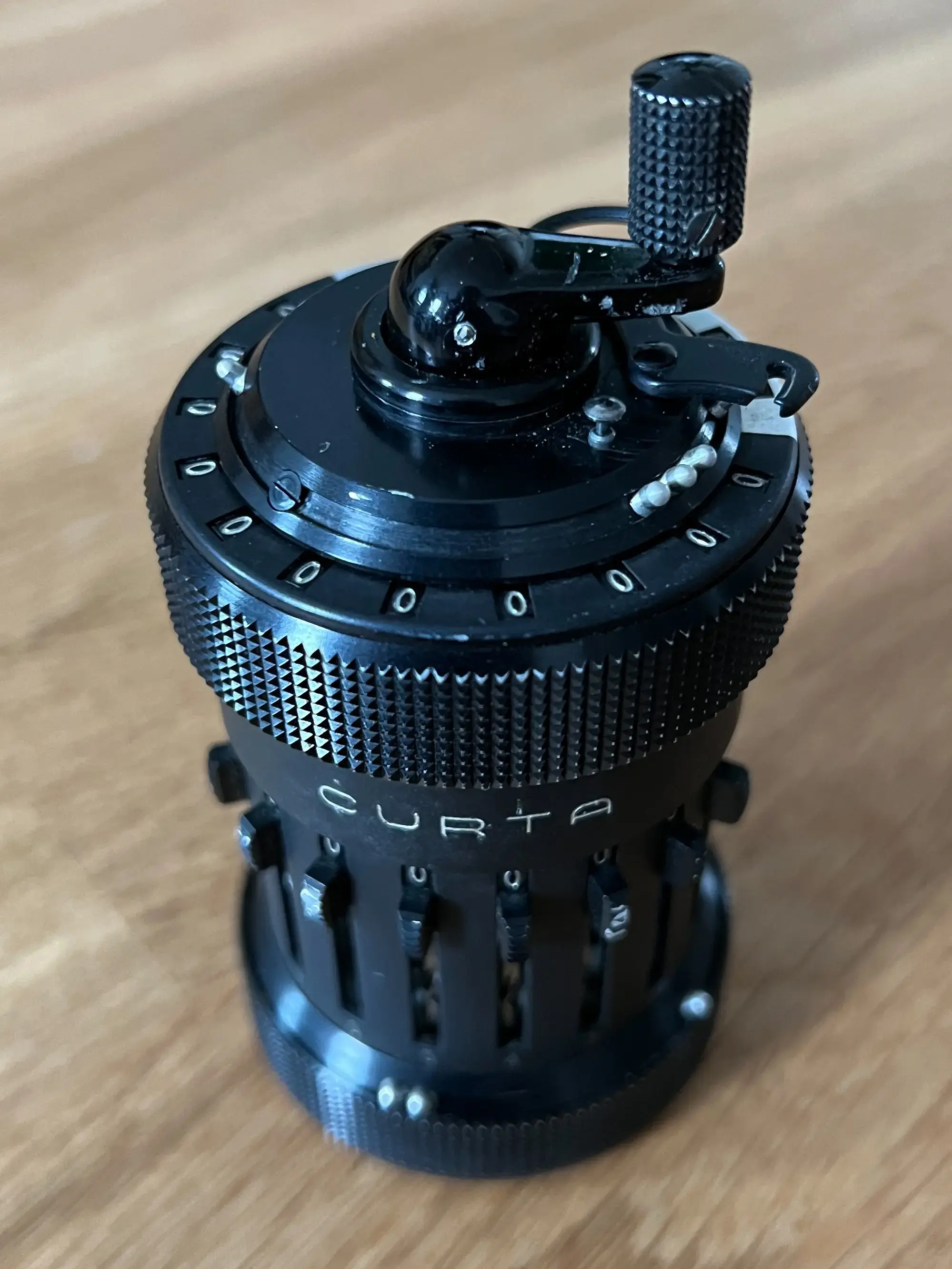
The Curta mechanical calculators were designed by the Austrian engineer Curt Herzstark, with initial designs from the early 1930s – being half-Jewish, he finished the design while being held prisoner at the Buchenwald concentration camp.
Here's some quotes from the wiki article:
> While I was imprisoned inside Buchenwald I had, after a few days, told the [people] in the work production scheduling department of my ideas. The head of the department, Mr. Munich said, 'See, Herzstark, I understand you've been working on a new thing, a small calculating machine. Do you know, I can give you a tip. We will allow you to make and draw everything. If it is really worth something, then we will give it to the Führer as a present after we win the war. Then, surely, you will be made an Aryan.' For me, that was the first time I thought to myself, my God, if you do this, you can extend your life. And then and there I started to draw the CURTA, the way I had imagined it. > — Curt Herzstark, Oral history interview with Curt Herzstark (1987), pp. 36-37 > > […] > > The Curta's design is a descendant of Gottfried Leibniz's Stepped Reckoner and Charles Thomas's Arithmometer, accumulating values on cogs, which are added or complemented by a stepped drum mechanism. > > Numbers are entered using slides (one slide per digit) on the side of the device. The revolution counter and result counter reside around the shiftable carriage, at the top of the machine. A single turn of the crank adds the input number to the result counter, at any carriage position, and increments the corresponding digit of the revolution counter. Pulling the crank upwards slightly before turning performs a subtraction instead of an addition. Multiplication, division, and other functions require a series of crank and carriage-shifting operations.
-
HP 71B Data Type error
My 71B is telling me "Data Error" whenever I try to use the variable "F" - any ideas?
-
Ronald Alan Hudson / Calcula · GitLab
Calcula is an RPN calculator with 26 stack levels and 26 storage registers. It is not programmable except you get the Pascal source code and you can create new, possibly complex, functions for the calculator.
https://gitlab.com/waspentalive/calcula
I am looking for suggestions for other functions to add and testing for the existing functions. Free. GPL3 License.
-
Casio fx-CG500

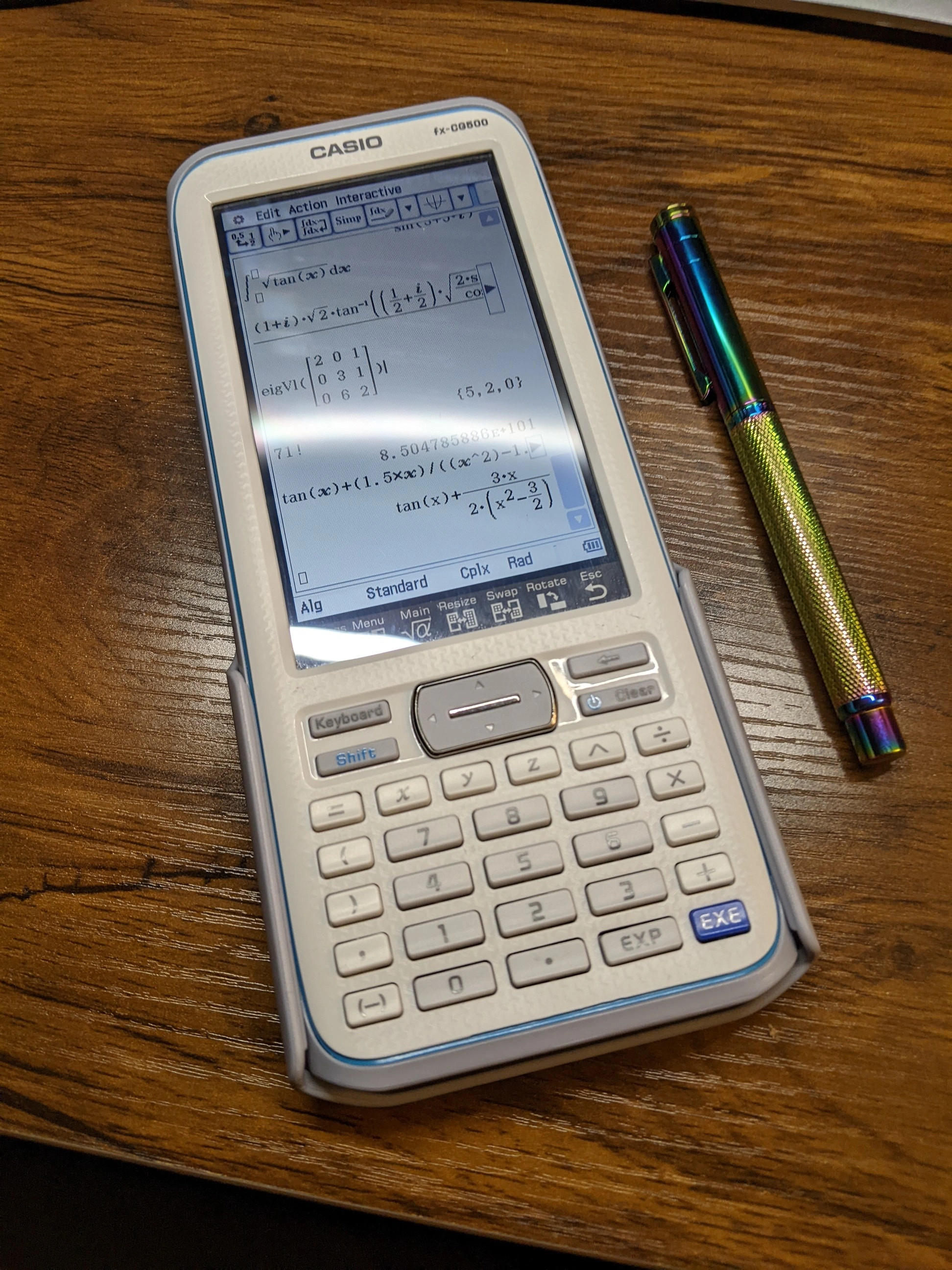
I've had this guy for about a 18 months and it is one of my favorites. It is slower than the HP Prime and the TI-nspire CX II CAS, but still blows the TI-89 Titanium out of the water as far as speed goes. The huge touchscreen gives it a unique UI that is easier to navigate than the TIs. I've found that this is the best of my collection for linear algebra, and it is the easiest of my CAS calculators to use.
-
This cutaway demonstration Curta is by far the most expensive collectible I've ever purchased.


You can see the bits moving around inside when you use it.

